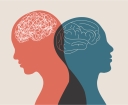Creative Thinking

Creative Thinking: A Skill You Can Learn, Not Just a Gift for Artists
Creativity is often seen as a mysterious force—something that some people are simply born with while others struggle to grasp. But is creativity truly an innate gift, or is it a skill that anyone can develop? From art and music to business innovation and scientific discovery, creativity is the driving force behind progress and originality.
Let's explore what creativity is, how you can cultivate it, and what neuroscience tells us about the creative process. We'll also debunk the myth that creativity is exclusive to certain people and discuss how anyone—regardless of profession or background—can learn to think more creatively.
The Different Forms of Creativity - Backed up by Literature
Creativity is the ability to generate new ideas, solutions, or expressions that are original and valuable. It is not limited to artistic endeavors but spans multiple domains, from scientific discoveries to problem-solving in everyday life.
In simpler terms, here are the creativity forms that we are all familiar of.
| Type | Description | Example Fields |
|---|---|---|
| Expressive Creativity | Focuses on self-expression and emotional communication. | Art, music, poetry, and writing. |
| Adaptive Creativity | Involves finding innovative solutions to problems by improving existing ideas. | Engineering, medicine, business strategies. |
| Inventive Creativity | Relies on creating entirely new concepts, tools, or technologies. | Scientific discoveries, product design, entrepreneurship. |
| Social Creativity | Uses collaboration and shared knowledge to generate new ideas. | Community projects, education, team-based problem-solving. |
| Emergent Creativity | Arises unexpectedly from the interaction of different ideas, disciplines, or technologies. | AI development, interdisciplinary research, cultural movements. |
Psychologists such as James Kaufman and Ronal Beghetto (2009), introduced the “Four C” model of creativity which includes:
1 Mini-C: Transformative learning involving personally meaningful interpretations of experiences, actions, and insights.
2 Little-C: Everyday problem-solving and creative expression.
3 Pro-C: Professional-level creativity exhibited by individuals who are creative in their vocation but not necessarily imminent.
4 Big-C: Creativity is considered great in a given field, often leading to historical innovations.
This model helps us understand the varying levels and contexts in which creativity can manifest.
The Neuroscience Behind Creativity
Let's get into the science side of things. Creativity has long been viewed as an abstract and mysterious phenomenon, but advances in neuroscience have provided valuable insights into how the brain generates new ideas.
The brain regions involved in creativity are as follows:
- The Prefrontal Cortex: Critical for planning, problem-solving, and evaluating creative ideas.
- The Temporal Lobes: Linked to memory and pattern recognition, which contribute to making creative connections.
- The Hippocampus: Facilitates idea association and retrieving information from past experiences to inspire creativity.
Aside from the anatomical importance, neurotransmitters also play a big role in creativity.
- Dopamine: Increases cognitive flexibility and divergent thinking, essential for generating novel ideas.
- Serotonin: Influences mood and can impact creative motivation and inspiration.
- Norepinephrine: Helps sustain attention and focus, which is crucial for executing creative ideas.
Additionally, neuroscientific studies have highlighted the role of neuroplasticity in creativity. The brain's ability to reorganize itself by forming new neural connections throughout life means that creative skills can be developed and refined with practice (Sawyer, 2011).
Therefore, it has been widely studied that creativity can be improved through cognitive exercises, mindfulness, and even physical activities such as walking or engaging in new experiences. Anyone can boost their creative potential by strengthening the brain's ability to make unique connections and increasing dopamine levels through enjoyable activities.
How to Become More Creative?
1 Engage in Divergent Thinking
Divergent thinking involves generating multiple solutions to a single problem. Instead of settling for the first idea that comes to mind, challenge yourself to think of at least five different ways to approach a task or solve an issue.
Tip: Try brainstorming sessions where you set a timer for 10 minutes and write down as many ideas as possible without judgment.
2 Expose Yourself to New Experiences
Creativity flourishes when you step outside of your comfort zone. Engaging with different cultures, hobbies, and disciplines can help you make unique connections between ideas.
Tip: Read books outside your field, learn a new skill, or travel to unfamiliar places to gain fresh perspectives.
3 Practice Mindfulness and Daydreaming
Letting your mind wander can enhance creative insights. Studies show that relaxed, unfocused states allow the brain to form unexpected connections between ideas.
Tip: Take short walks, engage in meditation, or set aside "quiet thinking time" where you allow your thoughts to flow freely.
4 Keep a Creativity Journal
Writing down ideas, observations, or dreams can help you capture fleeting moments of inspiration and revisit them later for creative projects.
Tip: Carry a notebook or use a digital app to jot down thoughts, doodles, and random ideas throughout the day.
5 Challenge Assumptions
Creative people question the status quo and look for alternative solutions. Instead of accepting things as they are, ask "What if?" or "Why not?"
Tip: When facing a problem, write down the standard approach and then deliberately try to come up with an unconventional way to tackle it.
6 Collaborate and Share Ideas
Exchanging thoughts with people from different backgrounds can inspire new ways of thinking. Group discussions and creative partnerships often lead to innovative breakthroughs.
Tip: Join creative workshops, discussion groups, or brainstorming sessions with diverse individuals.
7 Play and Experiment Without Fear of Failure
Creativity thrives in an environment where mistakes are seen as learning opportunities. Approach tasks with a playful attitude and don't be afraid to experiment.
Tip: Try engaging in activities like improvisational theater, freewriting, or experimenting with different artistic mediums.
8 Use Constraints to Spark Creativity
While unlimited freedom may seem ideal, constraints often force the brain to think more creatively.
Tip: Give yourself creative challenges, such as writing a short story with only 100 words or painting using only three colors.
9 Rest and Recharge
Creativity requires mental energy. Overworking your brain can lead to burnout and block creative insights.
Tip: Prioritize sleep, take breaks, and engage in leisure activities to keep your mind fresh and receptive to new ideas.
10 Develop a Creative Routine
Many great creators follow daily habits that encourage creativity. Consistency, rather than waiting for inspiration to strike, leads to long-term creative growth.
Tip: Set aside dedicated time each day for creative pursuits, even if it's just 10–15 minutes.
Creativity is not just an innate gift—it is a skill that can be strengthened with practice. By engaging in new experiences, challenging your thinking, and developing creative habits, you can cultivate and refine your creative abilities over time. Whether for artistic expression, problem-solving, or innovation, creativity can enhance all aspects of life.
We actually found, on average, it takes people 60 days to form a new habit. And what was important is that it varies widely depending on the specific behavior.
Ben Singh, Senior Research Fellow at the University of South Australia - ABC Life Matters 7 May 2025
Examples of Creativity
A house painter who is creative
Would you prefer to have a painter with a flare for creativity?
Check the simplicity of Blair's ideas for feature walls.
Creative programming
In fields like web development, programmers are not always regarded as being creative. Graphic designers yes. Web developers who are skilled programmers can come up with creative web projects a designer may not. For example most booking systems send you away to another site to complete the booking. A creative solution is to have intuitive booking systems within your own website.

References and Sources
Kaufman, J. C., & Beghetto, R. A. (2009). "Beyond Big and Little: The Four C Model of Creativity." Review of General Psychology, 13(1), 1–12.
Sawyer, R. K. (2011). The cognitive neuroscience of creativity: A critical review. Creativity Research Journal, 23(2), 137-154.
SEARCH ARTICLES
advanced search tips examples: "Yoga Meditation" Therap* +Yoga +MeditationRecent Posts

Nov 27 2025
The Psychology Behind the Primacy Effect

Jun 24 2025
Microplastic Exposure: Bottled Water vs Tap

Jun 09 2025
Squats for aligning hips

Apr 29 2025
Creative Thinking

Jan 28 2025
How to talk to someone you disagree with

Jan 27 2025
Alcohol Causes Cancer

Jan 14 2025
The role of the Amygdala

Oct 04 2024
A Support Guide for Anorexia Nervosa

Jun 25 2024
Sleep better



